Chapter 4
Custom-Made Worlds: Virtual Reality in Science and Business
Meteorologists (scientists who study weather and climate) would like to step into a hurricane to find out how the winds inside it behave—and come back out alive. Chemists and drug designers would like to examine the shape of complex molecules and build new ones, atom by atom. Paleontologists (scientists who study ancient forms of life) would like to travel back in time to see how dinosaurs walked. Since doing those things in real life is difficult or impossible, some of these scientists are doing them in virtual reality instead.
Many people think of virtual reality as little more than a high-tech toy, but a growing number of scientists, physicians, engineers, industrial designers, and businesspeople are coming to see it as a serious tool. It brings people in different countries together without the bother of a plane ride and lets them look at cars and buildings that have not yet been constructed.
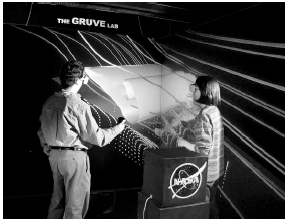
Molecules and Jets
One of the first VR systems to include a sense of touch, GROPE-II at the University of North Carolina, Chapel Hill, was designed to help chemists create new compounds by working with three-dimensional models of molecules. Electrical forces make a molecule attract some kinds of molecules and repel others. Touch sensors gave the chemists the sensation that molecules were sliding together if they were attracted or pushing away from each other if they were repelled. Today, improved programs at the same university let chemists see and feel individual atoms.
NASA used another early virtual reality system, VIEW, to create a virtual wind tunnel to help engineers and designers analyze the effects of air flow on planes and the newly developed space shuttle in the 1980s. More recently, the same agency's Glenn Research Center in Cleveland, Ohio, has employed a variation of the CAVE system, which they call the GRUVE (Glenn Reconfigurable User-interface and Virtual reality Exploration), to improve jet engines. "It's very difficult to understand the complex turbulent flow of hot gases in a jet engine," says Jay Horowitz, manager of the GRUVE laboratory. "Virtual reality lets [scientists] . . . immerse themselves in the hot flowing gases of the jet. They can make a change in the [engine] and then see how that change affects the fluid dynamics in the hot gas flow. This is critical for designing more efficient engines which produce less pollutants." 22
The Virtual Underground
Geologists working for some energy companies use virtual reality to help them find deposits of oil and natural gas. Their customized VR programs transform huge masses of data into three-dimensional images of underground formations and earthquake faults. The geologists can turn the images, zoom in on areas that they want to study more closely, and make slices through the virtual formations at different angles.
Shell Oil and Phillips Petroleum are two of the companies that employ virtual reality in this way. Designers working for Phillips created the conCAVE, a modified CAVE with a large, curved wall screen, a dome-shaped top, and a flat bottom, all of which can show images. Viewers can move a geological feature from one part of the display to another in order to study it in different ways. The floor view, for instance, is best at showing the direction in which a feature slants because it shows a flat, maplike view of an area. The wall views work better to reveal a feature's thickness because they are more three-dimensional.
Shell geologists navigate through their 3-D maps with a CubicMouse, a cube-shaped tool with three rods representing axes of length, width, and depth. By sliding and turning the rods, a viewer can make slices through a map in any direction. The rods can be locked into position so that people can pass the mouse around without altering the slice. Laurent Bourdon, a principle seismic interpreter for Shell, says that virtual reality and the CubicMouse became "immediately useful in reducing the time that it takes us to explore new drilling sites and to re-evaluate [oil and gas] reservoirs following several years of production." 23 The tools cut the time needed to plan the path of new wells by half and speeded up the overall design of the wells by 10 to 20 percent, Bourdon claims.
Dinosaurs and Ancient Cities
"Hard" sciences such as chemistry and geology are not the only ones that employ virtual reality. Some archaeologists use VR programs to re-create ancient buildings and cities. Brown University in Providence, Rhode Island, for instance, has developed a virtual reality program based on its archaeologists' discoveries about the city of Petra, which flourished about twenty-five hundred to two thousand years ago in what is now Jordan. Brown researchers use the VR system to visualize the structure of Petra's Great Temple, map the layout of the city, and see all the locations where particular types of finds, such as pottery, have been made. By combining all the architectural details and objects so far discovered into a life-size model of the temple, the VR program both serves as a record of the archaeology team's work and helps to bring the ancient site to life. Scientists at Brown are developing additional programs to help them make three-dimensional reconstructions of objects such as bowls from the fragments that they find at the site.
Biologists as well as physical scientists are experimenting with virtual reality. For example, Alexie A. Sharov, an entomologist (a scientist who studies insects) at Virginia Polytechnical and State University in Blacksburg, Virginia, has used VR to create life-size, 3-D models of insects such as cockroaches and grasshoppers. "You can even get swallowed by a grasshopper and find yourself in its abdomen," 24 he says. Similarly, in the late 1990s, paleontologists at the National Museum of Natural History, part of the Smithsonian Institution in Washington, D.C., used a computer to create a 3-D model of one of the museum's dinosaurs based on laser scans of its bones. The model not only helped the scientists improve the museum exhibit but gave them new information about the way the dinosaur probably moved when it was alive.
Virtual Surgery
Virtual reality has found many uses in medicine. One VR tool for surgeons, the DextroScope, lets them use images of patients to plan and experiment with complex surgeries before performing them on the real people. Surgeons in Singapore used the DextroScope in early 2001 to plan an operation to separate twin baby girls from Nepal who were joined at the head, for instance.
Augmented reality helps surgeons perform laparoscopic, or "keyhole", surgery, in which operations are done with small tools inserted into the body through tiny incisions. Because this kind of surgery causes less injury than traditional surgery with large incisions, it helps patients recover more quickly. That, in turn, lowers the cost of medical care because the patients can leave the hospital sooner. The drawback of keyhole surgery, though, is that surgeons can see what they are doing only indirectly, through images on a screen. Augmented reality makes their work easier by projecting CT or MRI scans of the operated area over the actual part being operated on. Surgeons who use
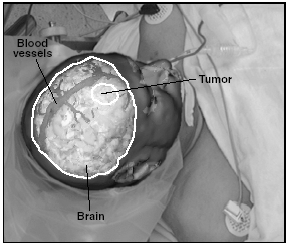
Some virtual or augmented reality systems for surgeons include touch information as well as visual displays. The surgeon may use this touch sense to control robot instruments that carry out the actual operation. Such instruments can make movements more precise than those of even the best human surgeons. Using a combination of VR displays, force-feedback touch devices, and robot arms manipulated by remote control, surgeons have operated on a beating heart through an opening in the chest that was smaller than the width of a pencil.
With similar blends of VR and robotics, surgeons can operate on people many miles away, allowing surgeons to "in essence . . . dissolve time and space," 25 as surgeon Urban Geisthoff says. This use of VR is still experimental, but in the future, such "telesurgery" might be used to operate on people in locations that are hard to reach, such as a rain forest, a submarine, or even a space station. The Department of Defense is looking into the possibility of using telesurgery on soldiers in battle zones.
In one of the most unusual medical uses of the haptic power of virtual reality, "E-touch" software from Novint Technologies in Albuquerque, New Mexico, combines touch sensors with three-dimensional ultrasound to let expectant parents have the sensation of touching their baby while it is still in the womb. Tom Anderson, head of Novint, says that the sensation is "a little bit squishy . . . similar to skin. You can feel along the surface [of the unborn baby, as translated from the ultrasound images] and feel a little bit of pressure and contour." 26
Fighting Fears
Some medical uses of virtual reality depend on programs that do not sound very appealing. One features a kitchen full of spiders. Another pictures a mountainside with a sheer drop to a valley far below. People use these programs in a psychiatrist's office, learning to overcome powerful fears called phobias. About 10 percent of people in the United States suffer from phobias such as fear of flying, fear of heights (acrophobia), and fear of spiders (arachnophobia). When these phobias are severe, they can keep people from holding a job or even leaving their homes.
Psychiatrists normally treat phobias by carefully exposing people to the things they fear, first in small amounts and then in larger ones, until they get used to them. A person who is afraid of spiders, for instance, might learn to play with a fuzzy toy spider, then watch a spider in a glass box, and finally be exposed to an uncaged spider. This process, called desensitization therapy, cures phobias or reduces them to manageable levels in at least three-quarters of the people treated. Arranging desensitization experiences, however, can be expensive, impractical, or even unsafe. Furthermore, when a person is exposed to an actual frightening situation, no one knows exactly what will happen. Patients may resist the treatment because they are afraid of losing control. Virtual reality can provide a solution to these problems.
Computer scientist Larry Hodges of the Georgia Institute of Technology and psychiatrist Barbara Rothbaum of Emory University in Atlanta made the first controlled study of virtual reality treatment for phobias in 1995. One of their programs treated people who were afraid of heights. It showed a virtual imitation of a glass-walled elevator, such as some expensive hotels have. Patients first saw a hotel lobby as it would appear if the elevator were on the ground floor. They then saw the lobby from one floor up, then two floors, and so on until the view showed the lobby from eight or nine stories up. Hodges and Rothbaum also tested a program that treated fear of
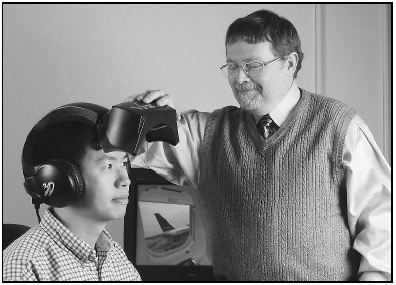
A number of psychiatrists and patients who have tried virtual reality phobia therapy say they like it better than the real thing. The chief reason is probably that both know the VR scenario is completely under the therapist's control. In a program to treat fear of public speaking, for instance, the therapist can make a virtual audience sit quietly, applaud, or yell and scream. This control means that the experience is never more frightening than the patient can stand. It can also be stopped at any time. Experiencing a frightening situation in virtual reality seems to make a good intermediate step between simply talking about it and facing it in the real world. Patients who refuse live desensitization therapy often accept the VR version.
Most VR phobia programs use head-mounted displays. Some involve other equipment as well. One program to treat fear of flying, for instance, includes a vibrating chair that imitates the motion of a plane and a sound system that mimics the noise of aircraft engines. Partly because of the equipment they require, VR phobia treatments can be expensive, and only a few psychiatrists have them. The treatments also give some patients simulator sickness or add to their difficulty in separating fantasy from reality. As technology improves, however, VR treatments for phobia are likely to become more common.
Virtual reality has been used to treat other mental conditions as well. One is posttraumatic stress disorder, which caused many soldiers who served in the Vietnam War in the late 1960s and early 1970s, for example, to suffer later from nightmares and flashbacks of terrifying experiences. A program called Virtual Vietnam lets such soldiers relive stressful situations, including flying a helicopter and walking through a jungle clearing, until they become desensitized to them and are better able to control their anxiety. Other VR programs treat vertigo (dizziness), eating disorders, cigarette addiction, and sexual problems. Programs that several people can use at the same time work well for group therapy, helping group members build a sense of community through their shared experiences.
Virtual reality scenarios can also help psychiatrists evaluate different kinds of brain function, such as memory, planning, and coordination. For example, children thought to have attention deficit disorder, which makes sitting still and concentrating difficult, can be tested in Virtual Classroom, a simulation of a schoolroom. The teacher in the simulation gives the child various assignments, such as working math problems. Meanwhile, the child hears noises and sees distracting events both inside and outside the classroom. (The child sees the outside distractions through a virtual window that looks onto a school playground.) The therapist measures how well the child carries out the teacher's assignments as the amount of distraction increases.
Controlling Boredom and Pain
People with physical problems use virtual reality, too. Patients whose brains have been injured by accidents or by strokes must repeatedly exercise certain muscles, such as those in their hands, in order to gain back full control of them. People with other injuries need different kinds of exercise, such as riding on stationary bicycles. Patients often become bored with these exercises and may refuse to continue them. They find, however, that pedaling a bicycle is more interesting when they watch a VR program that gives them the illusion of riding through a beautiful meadow, a redwood forest, or a mountain trail. Similarly, doing hand exercises becomes more fun when the user, wearing VR gloves, is chasing fluttering butterflies or playing a virtual piano.
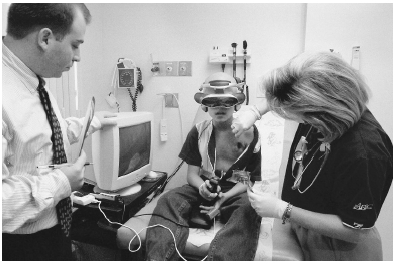
The distractions of virtual reality can do more than keep people from being bored; they can block actual pain. One VR program helps burn victims, who must undergo painful skin scraping every day. The program takes the patients on exciting adventures such as a deep-sea dive, a roller-coaster ride, or a trip to a ski resort. Using it "was like watching a movie," one burned teenager said. "I got totally absorbed in my virtual world and forgot about the pain." 27 Other experimental programs have distracted people receiving different kinds of painful treatment, such as dental operations.
Designing with Virtual Reality
Engineers planning a plane or a car or architects designing a building traditionally begin with two-dimensional drawings, or blueprints, and then proceed to three-dimensional work using computer-aided design (CAD) programs. They then usually build a clay mock-up and finally a complete, full-size model, called a prototype, for further testing. Prototypes, however, can cost up to a million dollars apiece, and new ones must be built if design problems are uncovered. A number of major car and plane manufacturers, architects, and other industrial designers, therefore, now save hundreds of hours and millions of dollars by building their prototypes in virtual reality before they make real ones. "If you can get it right the first time, it will mean a massive cost saving," 28 says Nick Matthews, principal research fellow at the Warwick Manufacturing Group, a British firm that helps businesses find uses for new technology.
VR prototypes help engineers because they can be examined from all angles, including some that would be difficult or impossible to see on a real prototype. With some VR systems, designers can even touch the virtual prototypes. They can also see how the prototypes will function. They can test plane designs in virtual wind tunnels, for instance. Viewers of virtual models of buildings can "walk" through them, noticing how the spaces inside relate to each
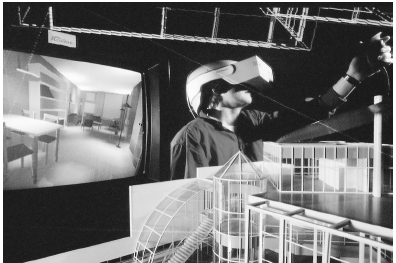
VR prototypes are handy to show to visiting executives, financial supporters, or potential customers as well. Groups can study them together, try out different possibilities, and look for problems that were not obvious in drawings. When flaws are detected, the designs can be changed immediately. In one early architectural use of VR, for instance, reviewers discovered that a wall that the architects proposed to build between the lobby and the hallway of a new building made the hallway too narrow. Because the problem was uncovered before the structure was actually built, it could be corrected easily.
Systems for building virtual prototypes are expensive, so only large companies use them today. They may become more widespread, however, as costs drop and businesses realize how quickly they can pay for themselves. A CAVE system costs about four hundred thousand dollars, for instance, but a single complete physical prototype for a car may cost two hundred thousand dollars. The CAVE, therefore, can earn back its cost when it eliminates the building of only two physical prototypes.
Cars and Buildings
Several European auto companies, including the makers of Jaguar Formula One racing cars, employ virtual reality to design their vehicles. Mercedes-Benz uses its VR center in Stuttgart, Germany, not only for designing but for crash testing. Studies have shown that results from these simulated crashes match the results from crash tests of real cars 98 percent of the time. The virtual testing saves money because it does not require expensive material to be destroyed. The computer also shows what happens to each part of the car, including parts that might not be visible or easily studied in a real crash test.
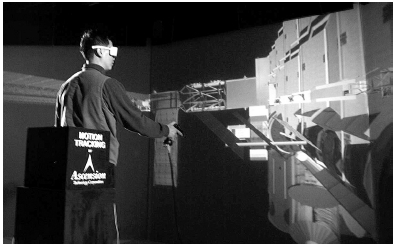
The Beck Group, an industrial architecture company in Dallas, has developed a VR design program that it calls DESTINI (Design Estimating Integration Initiative). Potential customers using this program first choose a general type of building from among several models. They then specify the size and number of floors they want and the types of materials they would like to use. In just a few minutes, the program turns these specifications into a three-dimensional model of a building. The customers and company architects can modify the model in various ways, trying out many possibilities. When they agree on a final model, the program generates CAD drawings, a list of materials, a cost estimate, a time line for construction, and an estimate of the amount of energy needed to heat and light the building. Beck officials say that DESTINI has reduced the time between their first meeting with a customer and the beginning of construction by up to 40 percent.
Other architects use virtual reality to show customers mock-ups of model homes. "By bringing the floor plans to life, buyers get a better understanding of what it would be like to actually live in this house," says Mitchell C. Hochberg, president and CEO of Spectrum Skanska, a builder of luxury homes in the Northeast. Such virtual tours are far cheaper to prepare than actual model homes, Hochberg points out. Hochberg calls the VR tours "our single most important marketing tool." 29
Long-Distance Meetings and Virtual Stores
Businesses use virtual reality for many purposes besides design. Executives in some large corporations with many branches set up virtual conference rooms for meetings, gaining most of the advantages of face-to-face communication without the expense and stress of long-distance travel. VR pioneer Jaron Lanier thinks that as computers and Internet communication grow more powerful, this type of technology will eventually develop into what he calls tele-immersion, which will convince conference participants in different locations that they really are in the same room.
Companies such as the maker of Pepsi Cola, use VR to plan and test displays of their products in supermarkets and convenience stores. Other businesses put limited forms of VR, chiefly panoramic 3-D graphics, on their Web sites. The Las Vegas Hilton and another Las Vegas hotel, the MGM Grand, offer Web viewers 360-degree views of their hotel rooms, for instance. Ford's and Toyota's Web sites include 3-D pictures of their cars, trucks, and SUVs. Some businesses even imagine a day when whole stores will appear on the Internet, complete with 3-D aisle displays and virtual clerks who call customers by name, remember their previous orders, answer questions, and suggest additional products that the customers might want to try. For some retailers, virtual stores may replace brick-and-mortar ones entirely.
hope that who are manage it can unload more article such these for others research..